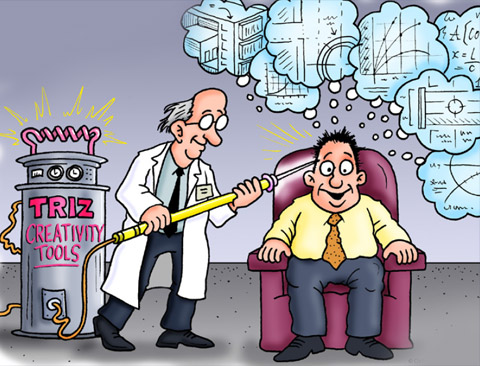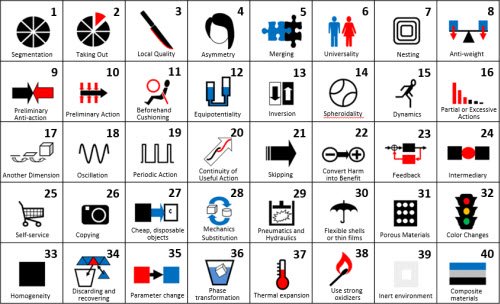TRIZ is the acronym in Russian of Teorija Rezbenija Izobretatelskib Zadach (Theory of Innovative Problem Resolution).
It seems wise to present to you this time an article about a theory created by the Russians at the end of the Second World War (1946) which aims to increase the ideality of a system, either by increasing its benefits or by reducing its costs or damages. TRIZ was developed by the Russian engineer Genrich Altshuller, after having examined around 200,000 patents of the Soviet Navy to later classify them by their inventive principle, established a process of necessary steps to follow in every new invention. Altshuller considered that: “The optimal results to technical and social problems are only obtained with a systematic thought so necessary for scientists, builders and inventors along with the imagination”
TRIZ includes a series of principles that must be learned and used to analyze a problem, model it, apply standard solutions and identify inventive ideas. However, the problem analysis phase and the synthesis of inventive ideas are reinforced if they are carried out in groups and under this methodology. It does not replace creativity, but it is a guide that is based on inventive principles already applied in world-class patents.
In 1986, the Theory of Innovative Problem Resolution became practical, with the establishment of the first TRIZ engineering companies in Russia. In 1992, this theory reached the United States, which together with Israel and Japan, has been one of the drivers of TRIZ. In the United States and Russia where the greatest advances in the field are made.
TRIZ is a technique aimed at solving problems. It has been used mainly for technological innovation. From a series of studies focused on the revision of thousands of technological innovation patents, 40 inventive principles were established that, in relation to 39 characteristics of the technological systems, serve as the basis and process for TRIZ.
In essence, TRIZ manages a correlation matrix that allows identifying possible solutions to a problem. The matrix contains features that worsen or improve the problematic situation. The crossing of these axes (worsens or improvement) with their specific characteristics establishes the principle of invention that is related to the problem and that probably helps the solution.

According to the TRIZ theory, there are two types of problems:
1. Those with previously known solutions
This type of problem can be solved based on previous information, that is, solutions can be applied based on others previously used in other previous problems.
2. Those with unknown solutions
According to Altshuller, the solution to these problems, called inventive, causes other problems.
TRIZ is considered a structured and effective tool to find solutions based on:
- You have to innovate in the right product, not in anybody.
- The main parameters in value must be improved, not in all.
- You have to find the root cause of the problem and not the initial problem wrongly raised.
- Focus on the main useful function and not on the components.
- We must resolve the contradictions and not only establish compromise solutions.
- You have to select the evolved products and not others.
- You have to collect and use global knowledge and not just the company’s knowledge, but someone else will do it for you.
- Adapt existing solutions and do not invent randomly.
- There are patterns of evolution of products and services, use them.
- All products tend to Ideality, as the ultimate goal, and there are rules to follow to obtain this.
You know that the same problems and solutions appear again and again in different industries, but that most organizations tend to reinvent the wheel instead of looking outside their own experiences or the experiences of their direct competitors.
Most organizations are very inclined to solve problems by adding things instead of making current things work more effectively, or by transforming things considered harmful into something useful.

Philosophy of Systematic Innovation – Five Pillars
One of the first discoveries of Genrich Altshuller and now one of the great ideas included in Systematic Innovation is that, among this excellence, someone somewhere has already solved their problem.
The Systematic Innovation recognizes that a world expert in its field is exactly that. He also recognizes that being an expert in a field is a full-time job. Few experts in a field have time to familiarize themselves with other fields. This, then, is where the method becomes an opportunity instead of a threat. The TRIZ research discovered the fact that very different industries are solving very similar problems, and that building an appropriate framework for knowledge makes it possible to systematically close the gaps that traditionally exist between different industries and sciences. The expert, therefore, has the opportunity to see how experts in other fields have solved similar problems. Even if, at first glance, those problems do not seem to be the same.
There are, of course, two sides to this story. The first is that we have a problem. In this case, Systematic Innovation will allow us to identify who and how this problem has been solved in other sectors. The second possibility is that we already have a solution. In this situation, the method can be used to systematically connect with industries that have not yet solved their own problems and, therefore, provide the opportunity to exploit more fully what we already have.
Beyond this great idea of putting all knowledge at hand in a common framework, there are five central philosophies that underpin this method.
The pillars are described in no particular order below:
Ideality
Ideology is in many ways similar to the concept of “value”. Ideality is defined as the sum of the benefits that a system delivers to its user divided by the sum of the cost of delivering those benefits and any other negative side effects that may occur (waste, waiting time, environmental damage, etc.). The original TRIZ researchers identified a very simple phenomenon common to all successful innovations: that all of them provided a level of ideality superior to the products and processes that preceded them.
In Systematic Innovation, this final destination is known as the Ideal Final Result (IFR). The IFR is defined as that point when the client obtains all the benefits he wants, without any cost or damage. While this concept may seem very theoretical, it at least offers a goal of long-term evolution.
Contradictions
It is often the first of the tools seen by newcomers to TRIZ or Systematic Innovation, Contradictions is probably the least implemented tool.
Contradictions of TRIZ is the need for problem solvers to actively seek out the conflicts and contradictions inherent in all systems. The second part involves using the methodology of Systematic Innovation to try to ‘eliminate’ those contradictions instead of accepting them.
The elimination of the contradiction is one of the most powerful of the tools of solution of problems of Systematic Innovation. A common phenomenon when eliminating problem contradictions instead of interchanging is that the benefits tend to extend beyond those initially identified during the problem-solving process
Functionality
In the traditional mapping of functions, the emphasis is on the establishment of positive functional relationships between the components. Systematic Innovation places considerable emphasis on drawing the positive and negative relationships contained in a system and, more importantly, in using function analysis as a means to identify contradictions in a system.
Functionality is the common thread through which it is possible to share knowledge among very different industries. A car is a specific solution for the generic function ‘to move people’, in the same way that a detergent powder is a specific solution to the generic function ‘remove object’. By classifying and organizing knowledge by function, it is possible for detergent manufacturers to examine how other industries have achieved the same basic function of “removing solid objects”. “The solutions change, the functions remain the same”
Use of resources
The fourth of the five philosophical pillars of TRIZ is the simplest, and is related to the unprecedented emphasis placed on maximizing the use of everything contained within a system. In terms of TRIZ, a resource is anything in the system that is not being used to its full potential. TRIZ demands an aggressive and seemingly relentless search for things in (and around) a system that is not being used to its full potential. The discovery of such resources reveals opportunities through which the design of a system can be improved.
In terms of Systematic Innovation, even bad things are good, we just have not thought enough about how to make the lemonade-lemonade transformation.
Space, time, interface
The fifth pillar of Systematic Innovation is to allow users to systematically highlight their thinking to avoid the problem of jumping to an incorrect problem definition. The human brain has not evolved to be creative. It has evolved to absorb scattered data and make decisions about that data. Sometimes, as in an emergency, this decision-making process has to happen very quickly. As a result, the brain very quickly makes assumptions about what a problem is and what to do about it. Unfortunately, the brain very often jumps to what turns out to be the wrong definition of the situation.
Application example
One of the first tools developed by Altshuller is the matrix of contradictions. This matrix has 39 rows by 39 columns. Rows and columns correspond to a list of 39 possible system characteristics. In the rows, the first characteristic of the system to be improved is selected, while in the columns the second characteristic of the system is selected that deteriorates accordingly, since there is a contradiction between the two. In the box corresponding to the selected row and column is a recommendation of which are the inventive principles that should be used to resolve the contradiction, culled from the list of the so-called 40 inventive principles.
As an example of application, suppose we want to increase the maximum speed of a vehicle (row 9), for which we use a more powerful engine and, therefore, heavier. An undesirable increase in the weight of the vehicle is thus produced (column 1). The matrix suggests us to use the inventive principles 2, 28, 13 and / or 38 to solve the contradiction. Principle 38, in particular, proposes the use of strong oxidants. In this sense, it is known that the use of nitrous oxide in automobile combustion engines allows to obtain greater power and, therefore, a higher speed, without increasing the weight of the engine, so the suggestion provided by the contradictions matrix It seems certainly relevant.
If you are more interested in the TRIZ topic, in this link you can find the II part of the article where I expand. TRIZ Methodology
WHAT DO YOU THINK? YOU INTERESTED
